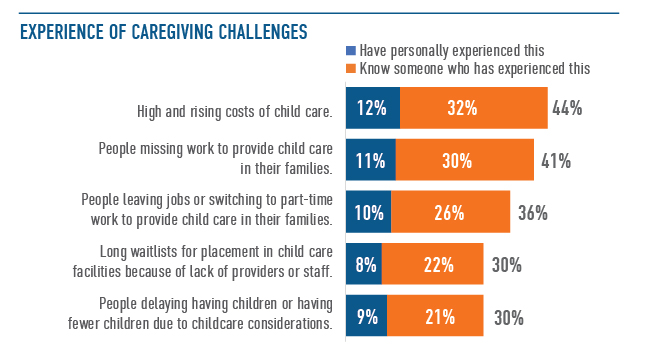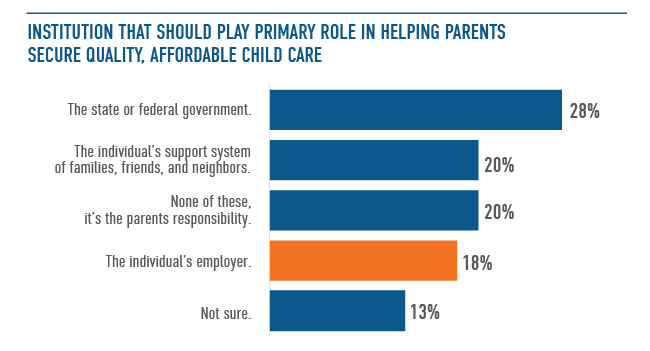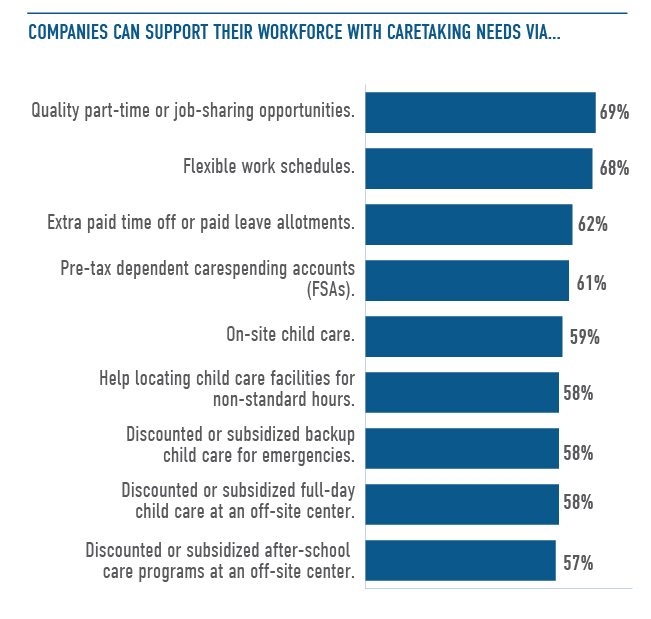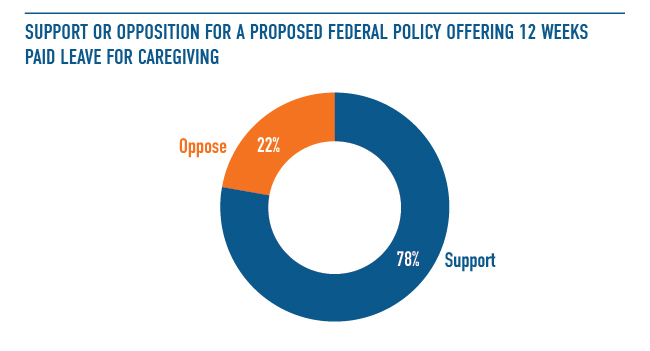JUST Report
Here’s What Companies Should Do to Help Their Employees Balance Caregiving with Working
- More Reports
- View All News & Reports on Polling
- View all JUST Reports
Key Findings
- Large majorities of the public are aware of the challenges of providing adequate child care while working during the pandemic.
- Respondents are most aware of the high and rising cost of child care in the U.S. (82%).
- 41% say they have either personally experienced or know someone close to them who has missed work to provide child care for their families; 36% say either they have, or they know someone who has left a job or switched to part-time work to provide child care for their families.
- Strong majorities agree that employers should provide different types of child care support for their employees.
- Foremost, respondents agree that companies can help their working parents by offering a greater degree of flexibility: part-time or job-sharing opportunities (69%), allowing flexible work schedules (68%), or giving extra paid time off or paid leave allotments for caregiving (62%).
- 61% say companies can offer financial assistance through pre-tax mechanisms such as FSA accounts.
- Additional support provisions include offering or helping locate child care facilities (59%), as well as offering discounted or subsidized solutions for various caregiving needs, such as back up or after-school care (58%).
- Additional caregiving support for families from the public sector would be welcome: 78% of respondents would support a federal policy that requires employers to provide up to 12 weeks of paid leave for workers who need to take care of a sick spouse, child, or parent.
Introduction
For working parents, the struggle to find adequate child care has never been easy, and the pandemic has significantly magnified existing caregiving challenges. For one, the availability of child care facilities has declined: many have either closed altogether, and those that have remained open have had to reduce their capacity to comply with public health regulations. In addition, many schools operated partially or fully virtual through the 2020-2021 school year, keeping kids at home but in need of supervision they would normally get while attending school in person. With rising uncertainties about whether the Delta variant will shutter schools again this fall, the pandemic-fueled child care crisis shows no immediate signs of abating.
Women, who traditionally carry disproportionate responsibility for caregiving in their families, have been the group most burdened by child care challenges. In 2020 alone, women spent significantly more hours providing child care for their families – 7 hours, up from 5.9 in 2019 – than men (4.9 hours per week in 2020, up from 4.1 in 2019).
The frenetic pace of providing care while continuing to work full- or even part-time contributed to more than 2 million women leaving the workforce in 2020. While quitting a job to care for family may be a short-term fix for caregiving needs, it ultimately has repercussions for women when it comes to career development and their representation in the workforce. With women leaving the workforce – and ultimately fewer earners in their households – there are negative implications for the health of the economy as well.
It’s clear that the pandemic has laid bare the precarity of child care in the United States. As a September 2020 New York Times article pronounces: “…the pandemic has highlighted how dependent the American economy is on child care. Without it, parents can’t work.” JUST Capital and our polling partner, The Harris Poll, checked in with Americans about their thoughts on the state of child care in the U.S., and their expectations of how companies can help parents balance caregiving responsibilities with working.
The Pandemic Shines a Spotlight on Child Care Challenges
Since the start of the COVID-19 pandemic, there has been no shortage of media attention on the challenges for parents of accommodating child care needs while working full- or part-time. Our research shows that awareness of the challenges of balancing child care with work responsibilities is strong, with more than three-quarters of respondents having personally experienced or heard of people leaving jobs (78%) or missing work to provide child care for their families (81%).

Additionally, more than 80% of respondents – parents and non-parents alike – are aware of the high cost of child care. Regardless of how child care is funded – be it tax credits, subsidies, or out-of-pocket spending – the cost burden on families is high and not necessarily going to level out any time soon. Data from a recent Fortune article shows that U.S. parents pay an average of $10,000 per child per year, a number that has grown since 2000 at a rate twice as fast as inflation.
The pandemic has also greatly impacted parents’ abilities to balance work and home, with some parents needing to quit their jobs in order to address caregiving needs. Significant portions say they have either personally experienced, or know someone close to them who has had to miss work (41%) or leave a job or switch to part-time work (36%) in order to fulfill child care in their families. The May 2021 Prudential Pulse of the American Worker Survey found that among the working caregivers they polled, 45% said they have considered leaving the workforce, compared to 19% of non-caregivers. Both findings clearly signal that the system is in need of repair if the only viable solution for families with caregiving challenges is to depart from the workforce.

Employers Can Offer Help
Working parents are at a breaking point and need assistance to find affordable, quality child care in their communities. Yet, when we ask who should shoulder most of the burden for caregiving, respondents are mostly divided on which institution could play a primary role.

About 3 in 10 (28%) say the onus should be on the state or federal government; 20% put the responsibility on the parents themselves or the immediate social support system of family and friends; and 18% say the individuals’ employer should take the lead.
The means by which companies can do that are multiple and varied. We asked respondents about specific ways companies can provide support mechanisms for their employees, and strong majorities agree that employers can help in ways both logistical and financial.

Foremost, companies can help their working parents by offering a greater degree of flexibility: part-time or job-sharing opportunities (69%), allowing flexible work schedules (68%), or giving extra paid time off or paid leave allotments for caregiving (62%). Some companies have already acknowledged the impact of flexible work on alleviating labor crunches. A recent Wall Street Journal article found that some manufacturers are being more flexible about worker schedules as well as adding on-site day care or helping employees find other childcare arrangements.
Respondents say companies can offer additional help by making financial assistance available through pre-tax mechanisms such as FSA accounts (61%), offering or helping locate child care facilities (59%), as well as offering discounted or subsidized solutions for various caregiving needs such as back up or after-school care (58%). These opinions are shared by parents and non-parents alike, indicating that there is strong consensus that companies could and should be doing more to help their workers with children.
Finally, a paid leave mandate for the private sector would additionally be welcomed, and not solely for child care: 78% of respondents say they would support a federal policy that requires employers to provide up to 12 weeks of paid leave for workers or who need to take care of a sick spouse, child, or parent.

Some of America’s largest companies have stepped up: a few of the country’s biggest tech companies, including Microsoft, Facebook, and Google, have offered paid time off and subsidized child care. Yet, a May 2020 survey by The Society for Human Resource Management (SHRM) shows that just two in five organizations have a dedicated plan in place for employees with childcare responsibilities, signaling that broadly speaking, companies are behind in building out a more tangible support infrastructure for working parents.
Vice President Kamala Harris recently convened a number of business leaders in order to build corporate support for child care, saying: “Affordable child care, we know, relates to both a business’s ability to recruit talent and retain talent.” The overall lack of child care support in the private sector has been a perpetual problem area for working parents. Schools and child care services shuttered during the pandemic, and foisting the burden solely on the backs of parents has magnified the problem a hundredfold. Americans show that they need support, and welcome their employers to play a role in that space. With hope, the lessons learned during the pandemic will be the catalyst for companies to make long-term changes to – or simply to create – corporate child care policies.
This survey was conducted online within the United States by The Harris Poll in partnership with JUST Capital from August 9–11, 2021 among 2,052 U.S. adults ages 18 and older. The survey is not based on a probability sample, is not representative, and therefore no estimates of theoretical sampling error can be calculated. For complete survey methodology, including weighting variables and subgroup sample sizes, please contact Jennifer Tonti, Managing Director, Surveys & Polling at jtonti@justcapital.com.